All the gear, no idea
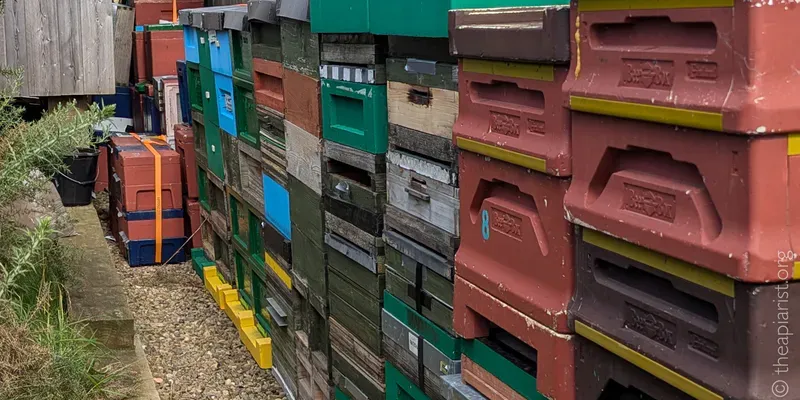
I received some worrying news this week.
The sort of news I dread but that, going by my history, shouldn't have been a surprise.
It brings significant financial implications, and threatens to upset my cosy middle-class existence.
I may even be forced to move house and downsize.
Again.
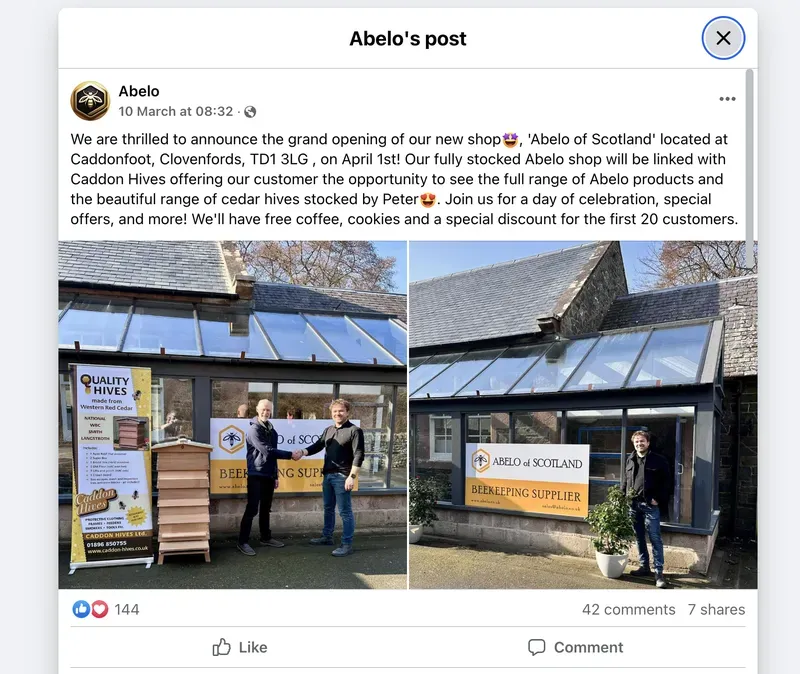
Those lovely people at Abelo are opening a Scottish branch.
This is a disaster … 😉.
All the gear
My beekeeping 'career' — and the nebulous 'profits' it generates — has been persistently blighted by my proximity to beekeeping suppliers.
In the Midlands a good friend was a Thorne's agent, and the annual BBKA Convention — together with its 'Oh so tempting' trade stands — was held at the nearby Stoneleigh Showground.
Together, they cost me a fortune.
I escaped to Fife around the time the Convention moved to Harper Adams, thankfully missing the wallet-lightening BeeTradex events that started up in their place at Stoneleigh.
But Newburgh is in Fife, and that's where Thorne's of Scotland are.
Funds released by the second remortgaging probably helped furnish their palatial facilities, the marble entrance hall, plush sofas and the free coffee and pastries for visitors.
Stopping working was a minor setback. A major fire in my research institute, shortly followed by the arrival of COVID-19, gave me an opportunity to escape to the remote west coast.
There are almost no beekeepers on Ardnamurchan, so no beekeeping suppliers.
Out of sight, out of mind … but no longer out of pocket 😄.
Wrong 😞.
I was nearly bankrupted by the additional shipping charges for pallets of jars.
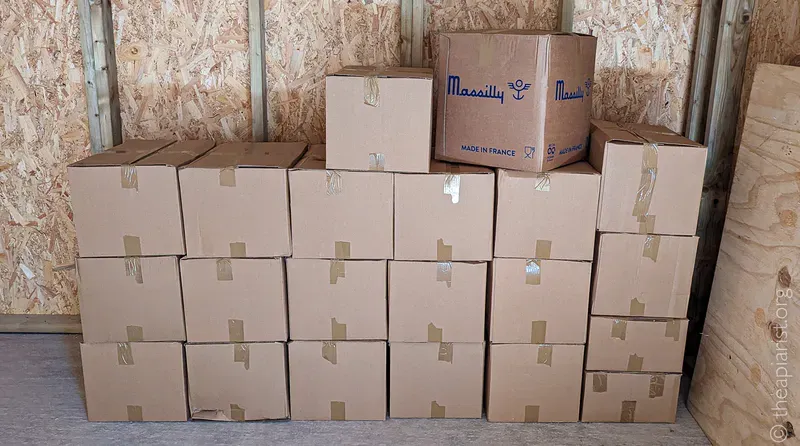
And, if that wasn't enough, most of my bees were still in Fife and I drove past Thorne's (“I'll just nip in and see if Brian's got any left-handed hive tools or 5.4 mm small-cell drone foundation in stock”) every week during the beekeeping season {{1}}.
Finally, last year, I moved to the Scottish Borders, bringing with me enough equipment to start my own beekeeping supply company.
I thought I was finally safe.
It's now only two hours to my Fife bees, but — critically — a different route that goes nowhere near Thorne's.
And now this … Abelo have teamed up with Caddon Hives and will be opening a store about half an hour away.
Obviously, with my presence in the neighbourhood, success is guaranteed. I'll need additional employment, but can probably find some evening bar work or a part-time job as a bouncer at a Jedburgh nightclub. I'll probably need both {{2}}.
In risu, veritas
Clearly, the text above contains exaggeration for (I hope) entertainment. However, James Joyce's hybrid {{3}} adage 'in risu, veritas' (in laughter, truth) applies.
I've spent a lot on beekeeping over the years, probably much more than I needed. I've bought things that I didn't require, or that were poorly designed or constructed, or that didn't last.
Most of this expenditure was in my early years of beekeeping.
I was enthusiastic, and didn't know any better.
I'm still enthusiastic.
I now usually know better.
Proximity to suppliers — or free postage over £100 — is a double-edged sword.
It's convenient, but it can get expensive. Some of that expense is necessary, but much isn't, and those new to beekeeping should either seek advice, or risk finding out the hard way.
It's another “do as I say, not as I do” {{4}}.
Beginnings
Warwickshire was a good place to start beekeeping. A large, friendly and well-organised local association, a good course for new beekeepers, and a conveniently-located teaching apiary. I spent many happy Thursday evenings there, first learning and then teaching (which resulted in even more learning {{5}}).
I left the last session of my 'Start beekeeping' winter course clutching a scrap of paper with a phone number of someone selling up (due to allergies) and a Thorne's catalogue.
Both cost me dearly.
A few days later I was the proud owner of a second-hand Thorne's 'Bees on a budget' hive {{6}}, a dinky little smoker, a large and unwieldy hive tool, an unflattering beesuit and a box of miscellaneous stuff I didn't then recognise.
And still don't.
The supers had been assembled incorrectly, and the bee space was trashed. Fortunately, the winning combination of brute force (some) and ignorance (lots) separated the supers into their constituent parts, enabling me to put everything back together more-or-less correctly.
Seemingly more rather than less, as those supers are still used every season.
As is the beesuit.
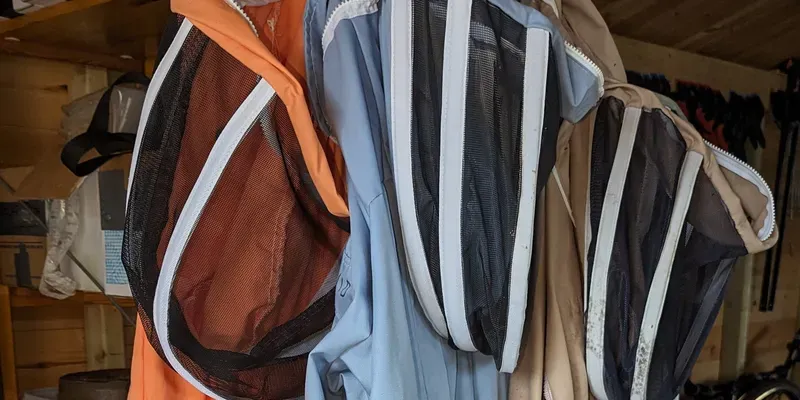
In fact, that beesuit is the one that gets the most use each year. I've subsequently bought additional suits and jackets (like the first, all from BBWear), but the — now extensively repaired — second-hand original remains my 'go to' suit.
I lost the hive tool.
I lose most hive tools 😞.
But that's easily remedied. The Thorne's catalogue lists dozens of alternatives {{7}}, some smaller, neater and more comfortable to use.
Though no less easy to lose.
Even the smoker still gets used occasionally, though I now favour larger smokers that are easier to light, easier to keep lit, but not quite easy enough to see when reversing the car {{8}}.
I think there are some useful lessons here for beginners about to start their practical beekeeping.
Hives
Everyone in Warwickshire used National hives (at least, they did when I started). The second-hand cedar hive I bought was a 'cheap as chips', but when new was still inexpensive {{9}}.
Inexpensive, not cheap.
As always, there's a difference.
It meant that when I got my first bees, supplied from a local beekeeper in a 5-frame National nuc, I could transfer the frames without drama. That's the very last thing you want on your first day of 'going solo'.
Once the supers were reassembled correctly — square and true — I could mix'n'match them with other National equipment I've subsequently bought or borrowed.
After returning north, those supers have survived over a decade of Scottish weather, spending the majority of that time stacked up with no protection. They're outside now, waiting for the OSR.
So, what are the lessons here?
- start with equipment that's compatible with that used by local beekeepers. You should be buying bees from them, and you may need to borrow equipment in your first year or two. Incompatibility makes everything more difficult.
- but be aware, having invested in one hive design, it's inconvenient — and expensive — to change. You shouldn't need to. Hives are just boxes and, of the popular designs (National, Langstroth, Dadant, Smith's etc.), none are fundamentally better or worse than others.
- cedar lasts well, and that first hive will probably outlast me. I've never used pine hives, though some do. I doubt they'd last as well in our damp Scottish climate, at least not without a regular application of preservative. Life's too short for that.
Poly hives and the 'new and improved models'
As the photo at the top of the post shows, I've got lots of poly hives.
Many are from Abelo.
That's not because they're better than any other poly hives, it's because they're compatible with the cedar boxes I also use.
By compatible, I mean I can mix'n'match the boxes. Not only are the frames the same dimensions, but the cedar and poly boxes can be stacked in any combination.
Some of the more recent Abelo hives are 'improved' by the addition of a rebate that makes the boxes interlock, and allows them to accommodate 12 frames within the National hive footprint. I'm sure these are perfectly good hives, but they're incompatible with other National equipment.
Might they also be incompatible with the next 'new and improved' National hive Abelo make?
Food for thought.
In a moment of weakness I bought a few Paradise-branded National poly hives. These are incompatible with other National equipment (What was I thinking?!) and are now relegated for use as bait hives. I'm sure the bees would do fine in them, but the inability to stack them with other National equipment is a dealbreaker.
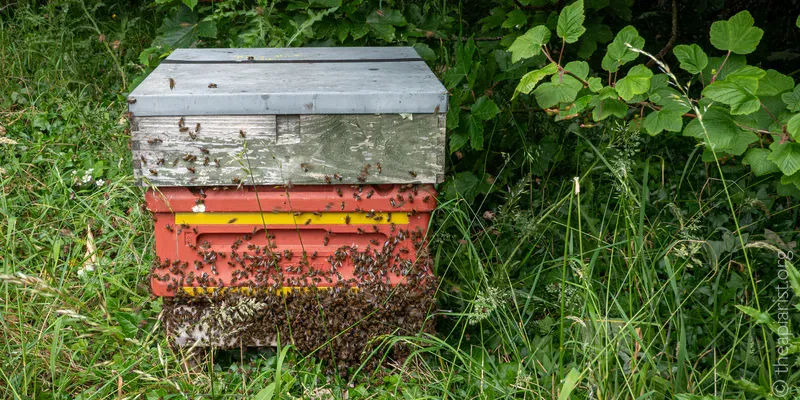
It's worth remembering that poly hives are produced from petrochemicals. Recycling is probably not an option, so they need to last a lifetime. Look after them, paint them to prevent UV damage, and do everything you can to keep them out of landfill. I've still got every poly hive I've bought {{10}} whereas a few cedar boxes have split or warped and ended up as firewood.
Future-proofing and second-hand value
It's also worth remembering that the bees don't care what sort of box they're in.
As long as it has enough space and provides sufficient protection — both in terms of insulation from the elements and ease of defence — the bees will be OK.
The things that vary in these 'new and improved' designs are (in my jaundiced view) features designed to attract beekeepers, rather than benefit bees.
And, if they also generate some additional sales because of incompatibility with previous models, so much the better {{11}}.
Most of this doesn't matter if you only have one or two hives (though, for peace of mind and self-sufficiency, I think you should aim for a minimum of three).
When you're starting out that might be all you ever expect to have. But, be warned, beekeeping can be addictive (in a good way). It makes sense to try and future-proof things from the outset by investing in hives that don't tie you to a single manufacturer or supplier.
If you get good at beekeeping you'll have spare bees to donate/sell in due course. It's a lot easier to do this on the frame design/size used by other beekeepers.
And, if beekeeping isn't for you (more start than continue), those custom-made, 13-frame, A-Ž Slovenian cassette hives will be a lot harder to sell than a 'vanilla' cedar or poly National 😉.
Some expensive items are worth it
The budget cedar hive costs perhaps 1/3rd the price of the top-of-the-range equivalent cedar hive. Functionally they're identical, so it makes sense to save your money.
I've got a couple of the premium brood boxes. They're lovely, but now cost over £100 and work no better than the £22 'seconds' sold during the annual sales.
But, as you gain experience, you'll realise that there are some items of equipment where spending a bit more pays dividends.
Again, not necessarily for the bees, but definitely for the beekeeping.
Two items immediately come to mind; smokers and queen excluders.
Smokers
My original smoker is stored, unused — though fondly remembered — for most of the season. But, periodically, it gets an outing. Usually this is because I forget to bring a smoker back from the apiary.
That first smoker was small and tricky to light. Once lit it tended to need quite a bit of attention — so burns through fuel faster — and regularly went out just before it was needed.
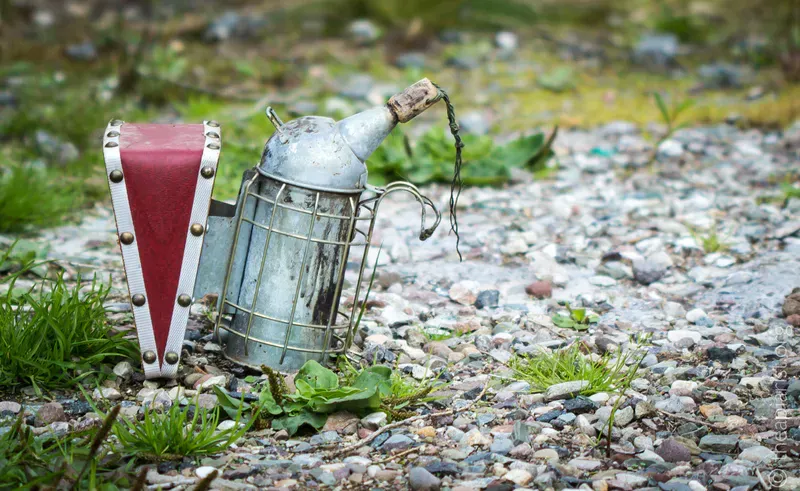
It was frustrating. In fact, it was infuriating.
When I started beekeeping I thought smoker-frustration was the norm.
However, having talked to my mentor and other experienced beekeepers it was clear they favoured larger smokers, and lit them with a blowtorch rather than a (readily-extinguished) match.
They made it look so easy.
Fortunately {{12}} I moved employers, and my colleagues gave me the 'smaller' Dadant smoker as a leaving present {{13}}.
It was a revelation {{14}}.
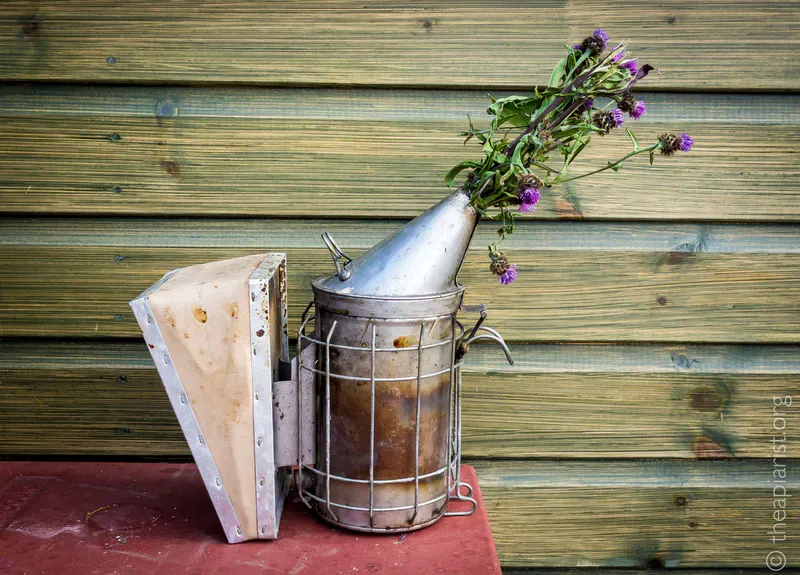
I subsequently purchased the larger Dadant model as well and they are both excellent. At about the same price as a premium quality brood box, they're expensive … but they are easy to light, and — like the Duracell bunny — keep going, going, going.
The initial outlay smarts a bit, but is soon forgotten.
Smokers, like hives, should last a long time, and having one you can rely on is very reassuring.
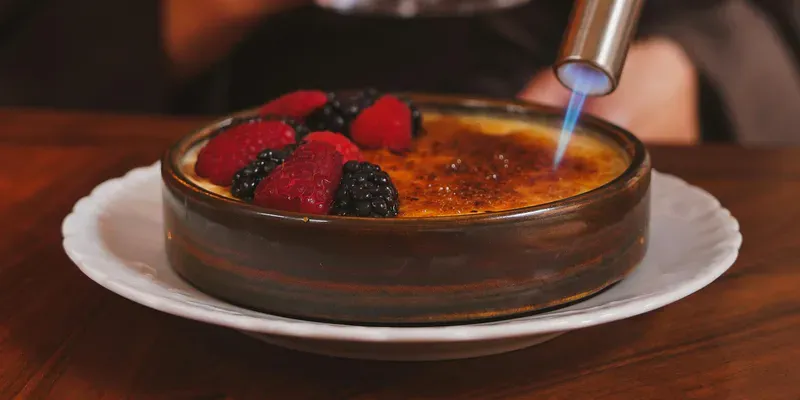
Top tip … use a kitchen blowtorch (as used for crème brûlée) to light your smoker. Smaller, lighter and easier to carry in the bee bag than a 'full-fat' blowtorch.
Queen excluders
I started with one of those ghastly zinc excluders. The bees would propolise it down onto the top of the brood frames, and if I wasn't careful and allowed it to 'ping' up when removed, it would fling an excitable cloud of bees into the air.
The el cheapo plastic queen excluders function almost as well — as bee catapults — but at least they don't crease and become unusable.
Instead, they eventually crack.
And become unusable.
The variants with little plastic stand-offs that prevent the 'propolis problem' by creating space above the brood frames — at least all the versions I've tried — tended to warp and (you guessed it) become unusable.
All the plastic excluders I've owned have been tricky to clean. All are relegated to the 'get rid of me' pile … which is not quite the same as actually being discarded, but they're not used.


Queen excluders, the good (left) and the ugly (right). The bad ones are stacked up in the background.
I only buy and use wooden-framed stainless steel excluders {{15}}. At over £28 they're much more expensive than the plastic equivalents, but they should last forever, are easy to clean {{16}} and don't fling bees everywhere when removed at the start of an inspection.

Just as important, returning them to an overcrowded brood box is straightforward as the wooden rim creates the correct bee space over the top bars.
Because they are easier to remove and replace, the colony is disturbed less. Fewer bees get crushed, so reducing the risk of disease transmission. And, because the colony is disturbed less, the bees are calmer, and there's a better chance I'll see what I'm looking for during a hive inspection.
Again, the initial investment might hurt, but it's worth it.
Essentials
I've only discussed five items of beekeeping equipment; hives, hive tools, smokers, queen excluders and beesuits.
There are a few other essentials needed when starting, but not many. Other than 'consumable' items like frames, foundation and nitrile gloves, the only other thing definitely needed is the equipment for use during swarm control.
If you were trained in how to use the Pagden method you either need to purchase a complete spare hive, or buy a 5 frame nuc and learn the nucleus method instead.
Of the two, I'd argue that the nucleus method is the better choice for a beginner … less equipment, less expensive equipment and boringly very dependable.
Actually, in my view, it's the better choice. Full stop.
So, with so few essentials, why are the beekeeping supply stores packed to the rafters with 'stuff' and the catalogues 100 pages long?
It's mainly for two reasons:
- they stock/list lots of things that are rarely, if ever, required. I know, as I've bought some of them and still haven't used them. Avoid these like the plague, though you may not realise you don't need them until long-after you paid for them 😞. At least when starting out, don't be tempted.
- these 'rarely, if ever' items, the essentials and the 'needed sometimes, but infrequently' kit (extractors, pollen traps and so forth) are available in a huge range of varieties; 10 smokers, 13 hive formats, 22 different hive tools, 35 different frame types and a seemingly infinite number of different types of foundation. Functionally similar, though often incompatible (life would be so much easier if we all used Langstroth/National/Dadant/13 frame A-Ž cassette hives … delete as appropriate 😉).
When drafting this I simply invented some realistic-sounding numbers in the paragraph above and — during proofing — had to increase them all to reflect the confusing extent of what's actually offered.
Choice is a good thing, but it can be confusing.
Choices, choices
Beekeeping is not an inexpensive hobby to start.
Minimise your outlay by buying wisely.
That's not the same as buying the cheapest stuff you can find. Some things, like a good queen excluder, improve your beekeeping every time you open a hive.
For a year or two's use, that seems like a wise investment.
Considering they should last a lifetime, that sounds like an absolute bargain.
A good beesuit is expensive but is likely to be well-designed, provide a comforting level of protection and be repairable when needed. I expect mine to last longer than I do.
Other things are perfectly good enough and reasonably priced, so why pay more for something that's functionally equivalent? The 'budget' hive is a good example.
Think about the future.
You might eventually want to expand your hive numbers, or you might decide to sell up and grow prizewinning onions instead.
In either case, purchasing equipment compatible with the majority of local beekeepers makes sense.
In my third or fourth year of beekeeping we had a once-in-a-generation summer nectar flow. I ran out of supers, but managed to borrow a dozen at very short notice from a friend who was 'downsizing'. That was only possible because we both used the same hive design.
As for everything else in the suppliers catalogue … ask yourself, is it really necessary?
Ask your mentor (you do have a mentor, don't you?).
Do they have one you could borrow?
If the answer is 'no' it's likely you don't need one either.
If it's an expensive item, like an extractor, see if your association has one you could hire.
I did this and quickly learned what sort of extractor I didn't want to buy.
My first purchased extractor was still poorly chosen (for me — too small and manual — I'd already underestimated my needs) but good quality. I sold it on easily and its replacement was much better suited to the scale of my beekeeping and has been in use ever since.
Personal choices
There's a final category of equipment that is essential, but very personal.
Hive tools are an example.
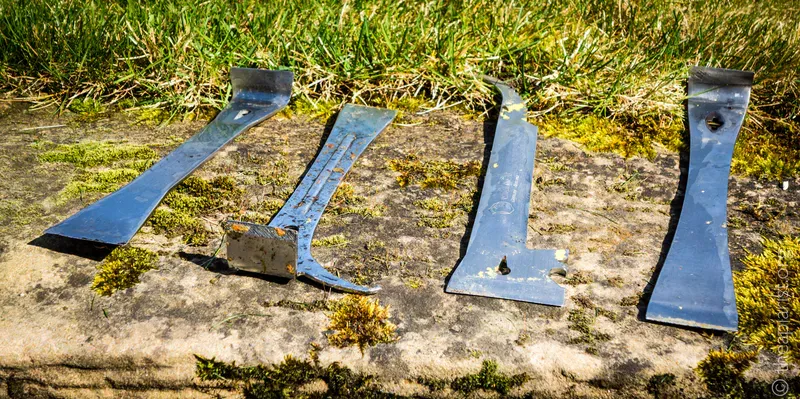
Try handling a few at a Convention, or in the shop, or during an association teaching session. You'll find some feel better than others. You might end up buying and using a couple before deciding on the type that suits you best.
And once you do, buy some many spares.
The combination of the long, tussocky grass in the apiary and the bottomless void in my bee bag is like the Bermuda Triangle for hive tools.
Second-hand equipment
A final word of caution about second-hand equipment.
Unless properly cleaned and sterilised this is a potential source of serious diseases including European or American foul broods. Everything needs to be scraped clean of propolis. Wooden-ware needs to be flame sterilised (use a big blow-torch) and poly boxes should be soaked in strong bleach. Vice versa doesn't work 😉.
If the person selling the equipment has said that all that has been done it's better to be safe than sorry, so do it again.
Sterilising a few boxes might take an afternoon. Losing your bees to these diseases is devastating and might take all your enjoyment out of beekeeping, meaning you give up.
And, if it's not sterilised, look elsewhere.
DIY
Bees are reasonably undemanding.
Someone — like me — with Neanderthal DIY skills can still make lots of perfectly adequate equipment at a fraction of the cost of the commercial equivalents.
Buy the essentials, but consider building some other items you might want.
In my case it's usually a triumph of 'substance over style' (it looks rubbish, but works the same as the item Abelo sells for £65) … but the bees don't care™️.
I have made many of my floors and roofs, almost all my split boards (Horsley, Morris, Cloake, double-screened, poor-mans, Snelgrove boards, and some weirdo experimental variants), lots of crownboards, clearers and feeders, and most things I use for queen rearing and honey processing.
In fact, except for the gleaming stainless steel stuff (extractors, QEs, smokers and hive tools), I've had a go — often very successfully — at making the things I use for my beekeeping.
I've saved a fortune, and learnt a lot about practical beekeeping in the process.
And, DIY enables you to make things that aren't available commercially … a subject I'll be briefly discussing in the post next week.
“A fool and his money are soon parted”.
Beekeepers aren't fools, but the same applies to new (and, in my case, not so new) beekeepers 😉.
Why not sponsor The Apiarist?
Despite the numerous mentions for equipment suppliers, The Apiarist carries no commercial sponsorship. There are no affiliate links, and I personally buy everything I use {{17}}.
The continued existence of The Apiarist is thanks to the valued group of sponsors who — in return — get frequent sponsor-only posts and the fractionally less regular BeeMusings newsletter. They help offset the server and software costs, and the considerable time I spend doing the writing and research.
Sponsorship costs about half the price of a premium quality cedar brood box annually, and — as you've now read the post — you have already saved that much, and more.
Join as a sponsor and enjoy every post.
Alternatively, the writing and research are fuelled by copious quantities of coffee. You can Buy me a coffee via the link (or the popup icon in the bottom left corner if you're reading this on the web).
Thank you.
{{1}}: Don't ask Brian for these, they don't exist. Have I identified a gap in the market?
{{2}}: Those of you who know Jedburgh will be aware that it has very few nightclubs, and anyone who knows me will be aware that I'm singularly ill-equipped to be a bouncer.
{{3}}: Appropriately (for my present location) 'That many a true word hath been spoke in jest.' from the Roxburghe Ballards and the Latin 'in vino, veritas' (in wine, there is truth).
{{4}}: Or did, before running out of money.
{{5}}: As I was usually only a week or two ahead of the trainees.
{{6}}: Only 30,000 careful owners.
{{7}}: That's a guess. Do I dare open the catalogue to find out? I know it will cost me money.
{{8}}: But that's a story for another time.
{{9}}: I risked a quick peek at the Thorne's website and see they're currently about £225.
{{10}}: Other than those sold with bees in.
{{11}}: Jaundiced … you were warned.
{{12}}: For so many reasons unrelated to the smoker!
{{13}}: It's only smaller when compared with the larger Dadant smoker.
{{14}}: The smoker, not leaving … though, now I think about it, leaving was a revelation as well 😉.
{{15}}: Stainless steel so unaffected by formic acid treatments. I don't use currently these … but I might, so I'm future-proofed.
{{16}}: Steam wax extractor and/or one of the wire scraping gadgets.
{{17}}: Apart from a gorgeous skep the Welsh Beekeeping Association once gave me after a talk at their convention.
Join the discussion ...